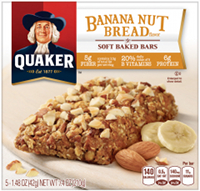|
Meet... Marianne O’Shea, Ph.D. Director, Quaker Oats Center of Excellence; Senior Director of R&D, Nutrition, PepsiCo.
Professional experience: Dr. O’Shea served at Lipid Nutrition USA from 2000 to 2010 and became director for North America. She joined PepsiCo in 2010 as director of global nutrition and was promoted in 2011 to senior director of R&D, Nutrition. Patents, published works: • Bassaganya-Riera J, DiGuardo, M, Climent M, Vives C, Carbo A, Jouni Z., Einerhand S, O’Shea M, and Hontecillas R. Activation of peroxisome proliferator-1 activated receptor and by dietary punicic 2 acid ameliorates intestinal inflammation in mice. Br J Nutrition (2011). • Racine NM, Watras AC, Carrel, AL Allen D B, McVean JJ, Clark RR, O'Brien AR, O'Shea M, Scott CE, and Schoeller DA Effect of conjugated linoleic acid on body fat accretion in overweight or obese children. Published March 3, 2010; doi:10.3945/ajcn.2009.28404 • O’ Shea M, Gerritsen J and Mohede ICM. Structured lipids in infant formula. Chapter 11 in book entitled "Handbook of Functional lipids" CRC press, p261-278, 2005. • O’Shea M., Devery, R., Stanton, C., and Lawless, F. (1997) The cytotoxic effect of conjugated linoleic acid on the growth of SW-480 and MCF-7 cancer cell lines. Irish Journal of Agricultural and Food Research 36: (2) • O’Shea, M., Lawless, F., Stanton, C. and Devery, R. (1998) Review: Conjugated linoleic acid in bovine milk fat: a food-based approach to cancer chemoprevention. Trends in Food Science & Technology 9: 192-196. |
|
Prepared Foods’ Food for Thought is a feature interview series involving food company R&D professionals, nutritionists, research chefs and other industry executives. In this fifth edition, Food for Thought talks with Dr. Marianne O’Shea, senior director, R&D, Nutrition at PepsiCo and the director of the Quaker Oats Center of Excellence. This June saw PepsiCo create the Center as “a cross-functional entity focused on elevating the relevance and benefits of oats through science, agriculture and innovation.” Officials say the Center of Excellence will investigate oat benefits and help product developers with related new product activities. Prepared Foods interviewed Dr. O’Shea shortly after PepsiCo’s mid-summer announcement. PF: How do you describe your day-to-day responsibilities? O’Shea: I am currently at PepsiCo leading and driving nutrition research to enable product differentiation for Quaker businesses globally. I‘ve been with the company since 2010, and I bring my broad experience in developing and marketing consumer-led claims to advance health benefits. Officially, I am still the senior director for nutrition. However, this new addition as director of the Quaker Oats Center of Excellence allows me to collaborate with and connect a cross-functional team to advance oat science. Prior to my current role, I was a director at Lipid Nutrition, an international company that produces scientifically sound lipid ingredients for the food, supplement and infant nutrition industry. I love being able to have a career rooted in science and discovery and am proud of the work shown in 25 peer-reviewed publications and patents. PF: Let’s talk about your career. When did you become interested in food nutrition? O’Shea: I’d say it was in university, during my formal education in biochemistry and nutrition. I learned how nutrition truly impacts health in a moderately gentle way; yet over many years this gentle impact can have a profound protective or detrimental effect on health. It then became very apparent to me that I had the good fortune of excellent nutrition through my childhood and I wanted to see if I could influence that for other children and families. What better way [to influence others] than to work at one of the largest food and beverage companies in the world. At Quaker, we aim to help mothers nourish their families by providing tasty, convenient and healthy solutions. PF: Let’s talk about life at your house. What’s your typical breakfast?
O’Shea: On the weekends when time is not limited, we make pancakes from scratch; steel-cut oatmeal with fruit, coffee and boiled eggs, religiously. And believe it or not, since I moved to the U.S. in 2001—long before working at PepsiCo—I have eaten Irish soda bread made with Quaker Oats, which I bake twice a week! Monday through Friday at the office, it’s oatmeal with cranberries (a big advantage of working for Quaker!). PF: How do you work oats and other whole grains into lunch and dinner? O’Shea: Oats can be a delicious and wholesome ingredient in many foods. At home, as I mentioned, we make Irish soda bread with Quaker oats. I also include Quaker oats in some of my other favorite foods including meatloaf, salmon burgers and oat-crusted chicken. We have a lot of great recipes on QuakerOats.com for anyone looking for ways to work oats into tasty meals for breakfast, lunch and dinner. PF: You worked at Lipid Nutrition prior to joining PepsiCo and Quaker. How do you apply that former experience? O’Shea: Lipid Nutrition is a highly innovative company offering proprietary products for better health. The synergy with PepsiCo, and especially Quaker, involves the passion for innovation. The goal is to know your core advantage—which, for Quaker, is the power of the oat—and continually bring that to consumers in meaningful, relevant ways that trigger an advantage and translate to better public health. PF: Let’s go back to the question of incorporating more oats and whole grains into meals. When it comes to nutritionists and groups such as the Whole Grains Council, is the key point to convey that there are tasteful, appetizing ways to increase whole grain consumption during other meal occasions—beyond breakfast? O’Shea: Absolutely. At Quaker, we work hard to educate people on the importance of eating more whole grains more often. In fact some of our newest products—such as Quaker Soft Baked Bars and Soft-Baked Oatmeal Cookies—make great snacks in the mid-morning, afternoon or after dinner. PF: We remember an oat bran craze (including oat bran beer) in the mid- to late- ’80s Do you recall it? Any thoughts about why oat bran became so popular and then why it went away? O’Shea: Yes, oat bran certainly had its time in the spotlight. While trends come and go and nutrition research uncovers more and more information, we have seen consistent evidence for the importance of whole grain. In fact, we see whole grains emphasized in the USDA Dietary Guidelines for Americans. However, research shows the average American eats less than one daily serving of whole grains. The oat is a whole grain that people love and it’s simple to add to the diet. PF: What have been a few key developments in oat foods research during the past two decades? O’Shea: It’s interesting because—in some cases—we knew certain things in 1990 about oats but [we] didn’t necessarily have the research and substantiation as support. For example, oats play an important role in satiety, which has not been very intuitive for families looking for satisfying meals. Yet now, the research is growing to support this and explore the mechanisms of action behind oats and satiety, which we know has to do with hydration of the fibers. Of course another key development was in 1997 when the health claim for oatmeal was approved by the FDA. That was a big development not only for oatmeal, but also for the nutrition industry in general given it was the first food-specific health claim. Lastly, we’ve learned more about growing oats and I think it’s worth mentioning developments in regard to environmental sustainability. The crop uses much less water and as a result there is less impact on the land. PF: Why was it important now to start this Quaker Oats Center for Excellence? What market need does it address? O’Shea: We’ve only scratched the surface on the power of the oat from many perspectives. The aim of the Quaker Oats Center of Excellence is to elevate the relevance and benefits of oats through science, agriculture and innovation, which in turn, could help close the gap in whole grain consumption. Who better than Quaker to bring attention to known and identify new benefits of oats and oat-based products? Quaker has been a leader in this important whole grain for more than 130 years. PF: Who will this center help? How? O’Shea: Our goal for The Quaker Oats Center of Excellence is to produce insights that are relevant to consumers as well as the industry. The Center now gives us an entity from which to innovate, communicate and bring convenient and tasty solutions to consumers. PF: What are the center’s resources, staffing and research capabilities? O’Shea: The Quaker Oats Center of Excellence is based at the Quaker headquarters in Chicago. It is not a traditional brick-and-mortar center. Actually, our oat expertise spans several locations including our laboratories in Barrington, Ill., our mill in Cedar Rapids, Iowa, and our oat growers in several regions across the continent. PF: What can you tell us about the new Center’s advisory board? O’Shea: We are in the process of building our advisory board with leaders across a variety of areas including nutrition science, agricultural science and sustainability. While we can’t provide names at this time, we are very excited about bringing this level of expertise to the Oat Center. PF: How will the center complement efforts by the Whole Grains Council? O’Shea: We have a long-standing relationship with The Whole Grains Council and have partnered with them on several initiatives throughout the years. While The Quaker Oats Center for Excellence is a separate entity, we share a similar goal and vision -- to help people better understand the numerous existing and potential benefits of the whole-grain oat. |


